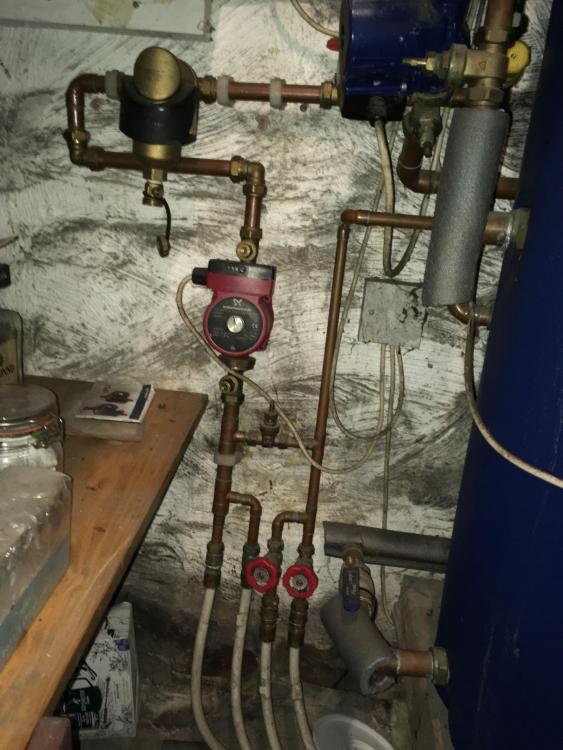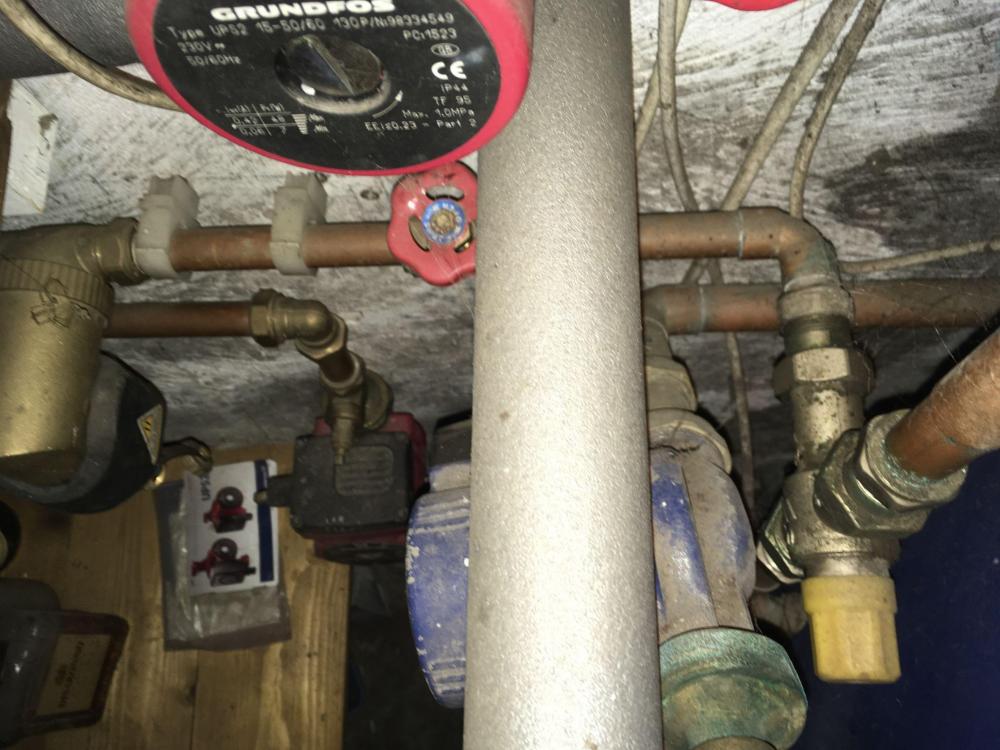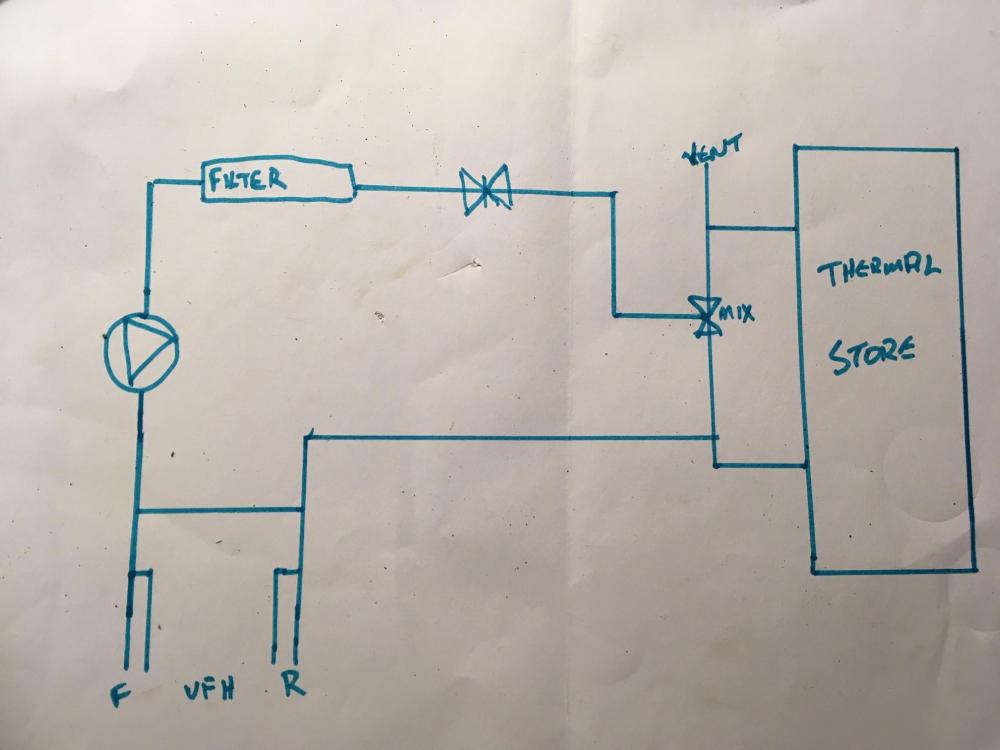
andygo
Members-
Posts
11 -
Joined
-
Last visited
Recent Profile Visitors
The recent visitors block is disabled and is not being shown to other users.
andygo's Achievements

Member (3/5)
0
Reputation
-
Um, OK well would you mind spelling it out for me please?
-
Hi This is stupid question maybe.....but grateful for any answers. If two inverter heat pumps of different sizes have the same heat load under the same conditions - neither of them operating at max or minimum - say a 7kw and 11kw - will they use the same amount of energy? or does the smaller heat pump always use less electricity than a bigger one? What's the formula to work out how much energy a heat pump uses? Thanks in advance Andy
-
Hi Could someone please walk me through adding a Willis heater to my UFH system (meant to do this last year, but only just getting around to it......) My UFH is a pretty basic system (see pics below). There are two loops for around 28m2 of UFH and no manifold - just two flow and returns - pump, filter, mixing valve (yellow knob) and end feed air cap. The UFH is currently connected to our Thermal Store - which at the moment isn't being heated (still working on replacing a solid fuel Rayburn). Presumably separating the UFH from the Thermal Store is the most efficient way of doing it - so the Willis isn't trying to heat the entire 270 litres of water in the TS. But I'd also like to keep the Willis in the system to use as a standby in the future once the TS is up and running again (and supplying the UFH). I'm guessing the Willis could go between the filter and the pump? If I'm separating the UFH (and creating an unvented system) I've read in the thread below about needing a small expansion vessel and cold water feed for it. Where's the best place to put the expansion vessel and where would I get the cold feed from? Could I use the current UFH feed from the TS? I've got an electrician friend to wire it up once it's plumbed in. Any help appreciated. Obviously if there's a better way of doing it, let me know. Thanks in advance Andy I put vent but I meant end feed air cap.
-
Help me switch my Rayburn off please! (UFH question)
andygo replied to andygo's topic in Underfloor Heating
Sadly, that's the way mine is set up. Life would be easier if there was a coil for the Rayburn and/or the UFH....but there isn't...they're both direct. How about if the panels were connected to both the UFH and Thermal Store via some sort of valve. If the water temp got too hot for UFH it would just be directed into TS instead. We're talking about winter sunlight, how hot do you think they're likely to get? Don't want to overcomplicate it though.... I can live without the panels for now...but I do want to find a way of heating up the UFH independently... -
Help me switch my Rayburn off please! (UFH question)
andygo replied to andygo's topic in Underfloor Heating
The underfloor heating is currently fed from the Thermal Store...which is what is causing the problem and the reason for the original post.... I want to separate the UFH from the Thermal Store for two reasons: 1 Currently the only heat source into the Thermal Store is a solid fuel Rayburn which is coming to the end of its days and a pain to keep running. If I can find another heat source for the UFH then we can possibly live without the Rayburn - or just fire it up on really cold days to power the radiators upstairs. 2 The water which goes into the Thermal Store gets black and sludgy because it's fed from the Rayburn. This same black, sludgy water goes direct from the TH to the UFH - so the UFH gets blocked up and I guess pretty inefficient. It was a poorly designed system from a plumber who has since disappeared... The long term goal is to replace the Rayburn with a better heat source. But in the short term (and fairly urgently as its getting colder) I need a way of ONLY heating the UFH. A Willis Heater heating ONLY the UFH would be cheap to install (and hopefully relatively easy to do) and would give me some solid figures to work with (though I am concerned about how much it might cost to run). Obviously in the long-term I'll add the thermal solar panels I've obtained to the Thermal Store....which will give us DWH in summer - but they're not going to do much to a 277l store in Winter. I'm wondering however if there is a way of taking advantage of the weak winter sun and use a panel or two to pre-warm the relatively small amount of water needed to run the UFH. (It might save us a few quid on electricity.) The question I have is does anyone know a way of doing that? And if so how many pumps would I need. Thanks again Andy -
Help me switch my Rayburn off please! (UFH question)
andygo replied to andygo's topic in Underfloor Heating
They are solar thermal and were free (because of leaks), no reason to sell on or send back. Since they won't contribute much over the winter in a 277l tank I figured they'd be better of making a more significant contribution to UFH using the little winter sun we get. In summer I'd hook them up to the thermal store and use them as designed. There's also a blending valve between thermal store and UFH....suppose I could incorporate that...but do you really think solar panels get that hot over winter? As mentioned earlier I'd really not have to go to the hassle and expense of getting yet another hot water cylinder when we've got a thermal store. -
Help me switch my Rayburn off please! (UFH question)
andygo replied to andygo's topic in Underfloor Heating
Hi, the problem with having a solid fuel appliance as a primary source is there's no constant to measure and compare (especially the way we used it) so I can't answer any of the questions above unfortunately. The only info I've got is what I've posted above. From memory I think there was around 6 inches of insulation below the UFH pipes - but I'm not even sure about that. Presumably installing a Willis heater will at least be able to give me a benchmark.... Since I last posted I've managed to obtain some used solar panels. I need to fix the odd leak, but once I've done that I was wondering about incorporating them to pre-heat water going into the Willis heater. Has anyone done something like this? Wondering about how many pumps I may need and anything else required...expansion vessel? As always any advice appreciated Andy -
Help me switch my Rayburn off please! (UFH question)
andygo replied to andygo's topic in Underfloor Heating
Thanks for the replies so far. We normally use anthracite nuts (smokeless fuel). There's a table here https://www.coals2u.co.uk/faqs/smoke-emissions-from-residential-buildings---a-summary-from-cpl/ giving details of their energy content (I can't pretend to understand it though.) In the real world we normally run the Rayburn at I would guess medium for around 4 hours. The max output is 16kw (not 12kw as I first thought) according to this where we bought it https://www.countrystylecookers.com/rayburn-ranges/supreme but it's nowhere near maximum when we use it (unless it's really windy outside) so I would guess there is around 8-10kw of heat going into the store for 4 hours (I know very little about all this though). The figure of 55kwh probably isn't too far out. After 4 hours the temperature at the top of the Thermal Store will reach around 80c and the return pipe at the bottom will be too hot to touch. If we put the central heating on for the radiators there's only enough hot water to keep them hot for an hour or so. Obviously on colder days we keep topping up the Rayburn to put more hot water into the thermal store. Another good reason for separating the UFH from the Thermal Store is that it's fed directly (not via a loop in the store), so the UFH gets blocked with silt fairly regularly. Having a clean loop for the UFH would make it more efficient no doubt. Experimenting with a Willis Heater seems the most sensible way forward (it's cheap to buy and I can use it as a back up if I get something else later on). What concerns me is how much it might cost to keep it running. I can work out how much it will cost to heat the thermal store - https://www.thegreenage.co.uk/much-electricity-immersion-heater-use/ But is there a formula to work out the cost of running 30m of UFH to a given temperature for a certain amount of time? Does anyone have any real world figures or can give a ball park idea...? I read on here about people heating a much larger area of UFH on 5 or 7kw ASHPs for pennies, albeit in a more favourable house than mine. The whole Rayburn/thermal store combo has proved to be a bit of a mistake (in hindsight I should have gone for the solar option from the outset) but you live and learn. What I don't want to do is make another expensive mistake.... Thoughts appreciated Andy -
Help me switch my Rayburn off please! (UFH question)
andygo replied to andygo's topic in Underfloor Heating
Hi, thanks for reply. I can't edit the last line of my original post, but to be clear... we like the UFH and want to keep it. So what I'm looking for are ways to power the underfloor heating (either at the same time as radiators and DHW or independently). I'll have a look at the heat model link, thanks. -
Hi all I've been doing quite a bit of reading up on this forum, but this is my first post (please be gentle). I'm looking for advice on changing the heating source for our UFH from a solid fuel Rayburn to something else (most likely either a ASHP or Willis heater - open to other suggestions). Our house is an old stone 2-bed cottage with no mains gas. The Rayburn has been our main source of heating in winter for the last 12 years (we have an electric shower and cooker for the rest of the year and just boil the kettle to wash dishes). In winter, the Rayburn (a 12kw Supreme model) supplies hot water to a 277 litre Gledhill RE Torrent Thermal store - which in turn heats 30m2 of UFH (concrete slab and flagstones) and 4 radiators upstairs. We've been planning to add solar panels for years and will one day when I get around to it... Anyway... the Rayburn boiler is getting very rusty and I suspect will start leaking any time soon and I'm also sick of schlepping coal in and out on cold winter nights so it's time for it to go, or at least not be the primary source of heat anymore (my wife is still attached to it....) For the last few years the way we've used our heating system is to light the Rayburn in the late afternoon (using about 10kg of coal), and let it burn out by the time we go to bed. That puts enough hot water into the Thermal Store so it heats up the slab overnight and lets us run the radiators for an hour or so before we go to bed (if it's windy we get enough hot water for a bath!). We use on average between one and a half to two tonnes of coal over the winter months which costs £400 - £500. Although the house is drafty, the UFH works well and the house manages to stay reasonably warm (downstairs at least). We also have a wood burning stove. I don't really want to install another type of fossil fuel boiler and would prefer a more sustainable alternative/s. I'm also planning on making the house more airtight. There's lots of insulation in the attic and we've put in double glazing. In an ideal world I'd simply replace the Rayburn with an ASHP... but having exchanged a few messages with Nickfromwales he's advised it wouldn't work and says I'd need to change the thermal store to a UVC - or at least add another buffer cylinder to the system which I'd really rather not do. We don't really have the space for yet another cylinder. I did wonder if it would be possible to connect a smaller ASHP direct to the UFH - maybe with a radiator as a buffer in the kitchen (which would be unheated without the Rayburn). Nick wasn't convinced about this either... Otherwise I'm wondering about using a Willis heater - at least for this winter as a short term fix. But I would like to get some idea of how much that might cost to run. Does anyone have a ball park for how much it would cost to run to heat up 30m2 of UFH...(I'm currently on Igloo variable standard tariff of 13.9p.) Obviously it would be better to heat it overnight. Igloo don't do Economy 7 though I can change to another supplier easily.....but our current electricity usage is already around 3,500kwh per year - so any E7 savings may be negated by daytime use. (We're a family of three so presumably the electric shower and kettle boiling accounts for alot of that). I'm happy to fit a Willis heater (I've a friend who's a qualified electrician to wire it in) but I've also got a few basic install questions - where does it go, how many would I need, does it need its own pump or can I use the UFH pump - as mentioned in the thread below? Out of interest if we did go for a Willis Heater is there a way of plumbing it into the kitchen hot tap too? Appreciate any help or advice and especially any other better ways of heating our home. Many thanks Andy




